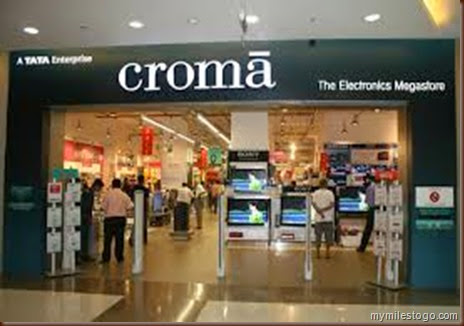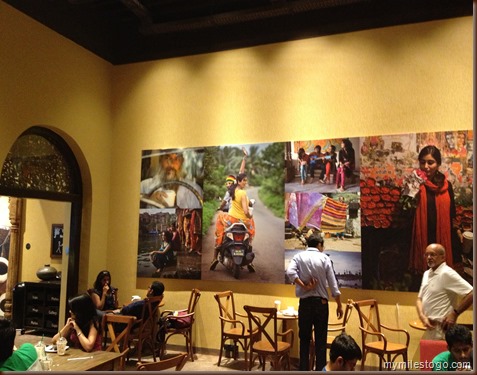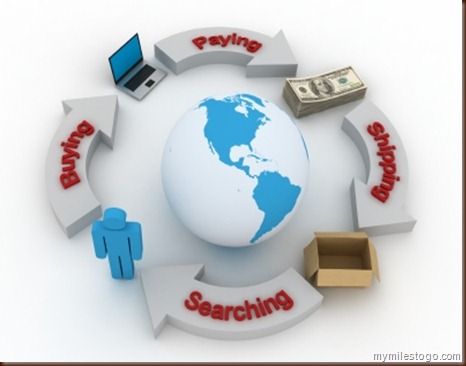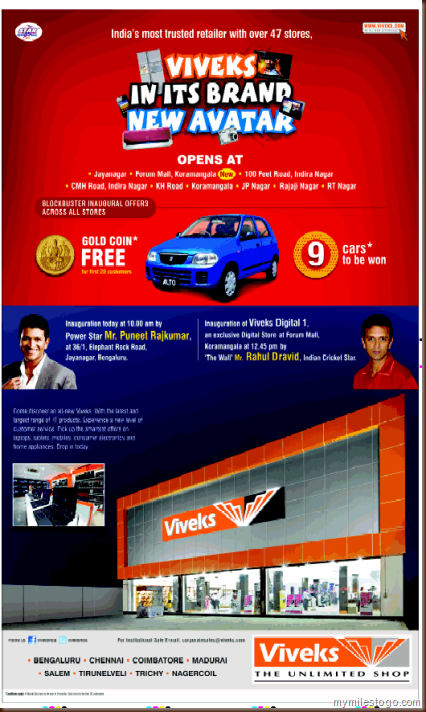07 April, 2017
F for FDI in Food Retail
31 March, 2016
FDI in Ecommerce
17 April, 2014
Digital Retail is still nascent
Croma, which is a part of the TATA Group has been my preferred store for shopping all things electronic over the past few years. They customer service is friendly, well-stocked and well maintained and operated stores. The staff also double up as digital experts, mostly guiding customers on why they need to buy a gadget, rather than what they need to. The apple Assistant at one of the Croma Stores I frequent is more like a good friend and advisor now – I reach out to him regarding queries about the phone, the software, the enhancements and a whole lot. Croma’s main competitors in the organized Retail space include EZone from the Future Group and Reliance Digital, a part of Reliance Retail. Then there are the local biggies, such as Viveks, Shahs, VGp, etc in Chennai and ofcourse the most infamous Ritchie Street off Mount Road which is the hub for electronic products in the city. Croma has fared much better than the others while it faces stiff competition from Reliance which is expanding rapidly off late.
I visited the Croma Store on Mount Road a month back, to enquire about a revolutionary device – a a USB Stick which provided 3G & Wi-Fi services on the go. The device just needs a plug point – AC or DC; which means you can use it as a wi+fi device using the cigarette lighter slot in your car and can provide its service upto 5 gadgets including laptops, tablets, phones, iPods, etc. The device has been around for sometime and the staff say that it is seeing brisk sales every other day that it gets sold out within a few days of stocks coming in to the store. So, the store that I went to didn’t have the stocks and they apologised for the same, and said that I could pay the advance for the device and that they would call once the device reaches the store. Somehow, I wasn’t comfortable with that idea, since I wanted the device then and there.
I set out looking for the Tata DOCOMO Store that exclusively sells these devices and offers other solutions and services of the same nature. Even they didn’t have the stock at the time I went. However, the staff was quick to note down my details and said he would call me the next day as soon as he received the stocks. And he did promptly call me the next day. Within just four hours, the device was working!
So, why did the guy at Croma not do what the guy at the DoCoMo store did? Since, the sales targets were different to each one of them, simple. For a mass retailer, which attracts hundreds of customers to their stores, the kind of focused service is always on the back seat. For the guy at the exclusive store, his key targets are selling the USB sticks and converting buyers into users and users into big spenders. It’s a known fact that “data usage” is indeed going to be a money spinner in times to come for Telecom companies, with SMS being replaced by the likes of whatsApp and ISD calls being replaced by the likes of Viber, Line, etc.
I would have expected Croma, which is also a Tata Company to work closely with another division of the group (DoCoMo is a Telecom company operated by Tata Teleservics). It is challenging, since they are different companies with different cultures. Also, the supply chain mechanism could be different. The big learning was as consumers, we need to visit the right kind of stores to get our things done. While it is simpler to buy online, it takes much more time to get the sim-card activated which required personal identification at a retail store, and hence only elongates the process.
26 March, 2013
Alternate ECommerce–Auction Sites
There was a cover story about Alibaba.com, China’s largest ECommerce company in recent issue of The Economist. Quite a few facts. That it is turning out to be one of the largest ecommerce companies in the world, with sales of over $170 billion, which is Amazon and eBay put together. That it has a financing division, viz., AliFinance which provides micro credit to small firms and consumers; and that it has 6 million vendors registered on its site. What was started in 1999 by the firm’s founder, Mr. Jack Ma, an English Teacher as a B-2-B portal connecting small Chinese manufacturers to overseas buyers has now transformed into an internet behemoth. “EBay may be a shark in the ocean,” Mr Ma once said, “but I am a crocodile in the Yangzi river. If we fight in the ocean, we lose; but if we fight in the river, we win.”Taobao, a consumer-to-consumer portal not unlike eBay, features nearly a billion products and is one of the 20 most-visited websites globally. Tmall, a newish business-to-consumer portal that is a bit like Amazon, helps global brands such as Disney and Levi’s reach China’s middle classes.
Indiaplaza, which was also founded in 1999 back home in India is unfortunately facing its toughest time yet. With over 80% of its 150+ workforce having quit over the past six months, the company which pioneered ecommerce in India has no takers today. With a weak b-2-c model based on product listing by various partners, the company has just not been able to scale up over the last few years, thus allowing late entrants like flipkart, myntra, jabong and coupon sites like snapdeal and groupon to surge ahead. To be fair to Indiaplaza, most of the Ecommerce sites in India are on deathbed, awaiting Angels to come and save them. The top three players, Flipkart, Jabong & Myntra with sales of over USD 600 million collectively are only making losses and there no signs of any profitability in the immediate future. Offline Retailers have had a slow start without much success in this arena. Croma, part of the Tata Group’s Trent Ltd., Crossword, India’s largest book store chain along with Landmark and Shoppers Stop, India’s largest Department Store chain are the only few large Retailers who have attempted an Ecommerce entry over the past years. With FDI in Retail not included for Ecommerce businesses, the Government’s backing has been minimal in this regard.
Even as I was thinking so, I came across an article which mentioned about an auction site named QuiBids (spelt as KweeBids). More out of curiosity, I set-up an account to know how this works. Registration was simple.GBP 0.40 is the value of each bid (for the UK Site) and can be bought online at the store in bundles that the user can choose, which in turn can be used while placing bids or while buying an item on the site after discounts and offers. The joining fee will be refunded in full or part thereof if bids are not placed for the said value. They have listed hundreds of items and all of them are on auction. The products are genuine and the processes are audited by Grant Thornton, one of the top audit companies in the world (I have personally seen the audit assurance report which is published on their website). One can bid an item only 5 minutes before the bid time comes to an end. Which means, users keep track of all those items on bid and are probably hooked on to the site all through, if they want to participate in the bidding process. Each time a bidder places a bid, the time slot for the auction increases by 20, 15 and 10 seconds in that order. If the number of bids the user holds is over, then he/she cannot participate in the bid anymore but the value in their account can be used against purchases. Also, the value of the product is discounted to the extent the bids are placed by users. Which means, if a product is priced at, say GBP 100, and the auction ends at GBP 32, with a discount of GBP 9, then the user can buy the product for GBP 91 (less the value that is already in the account). Shipping is charged depending on the size and weight of the product. All in all, it is a win-win for the company and the user. The company makes a thin margin on sale of such products while the loss on bid money is usually written off against a publicity fee paid by the brand to feature their products. And on top of it, users also buy the product which is at a discount for them but which fetches a margin for the company. In addition to this, users may also buy “bids” for set values, so as to keep on bidding. At the end of the day, a user will only gain from the tremendous discount that he gets out of the product even after buying bids.
The prose above may not be fully convincing, so do log on to www.quibids.com to explore.
According to their website,
“QuiBids was started in July 2009 as an attempt to improve the Internet auction model by making it more exciting, safer, and more reliable. We're based out of Oklahoma City, Oklahoma and our goal as a business is simple: To provide an exciting online auction model with better deals for the consumer than any other website in existence."
You can win all sorts of popular products at incredibly low prices. Look at our homepage to see what products are up for auction right now, and if one catches your eye, buy some bids for a low price! When you place a bid, we add a maximum of 10-20 seconds to the timer - to give someone else the chance to bid if they're interested. This is similar to the "Going Once...Twice...SOLD" approach of auctions.
If no one else bids and the timer reaches zero, you’ve won a sweet deal on QuiBids! If you don't win the auction, you never have to go away empty handed. Any time after you've placed your first bid in an auction, you can choose to buy the product for a discount using the Buy Now feature. This will help limit your losses so you don’t have to leave all your bids on the table. You’ll never have to pay more than the Value Price for any products on QuiBids.
I have never come across such an exciting business model which I can comfortably say is an alternate Ecommerce model. There is hardly any publicity that I see for this company or for this form of Ecommerce and yet there are hundreds of dedicated users who are constantly bidding to win their favorite products at rock bottom prices. I guess the typical profile of the customer would be in their 20s and this is almost like a contest for them! Internet penetration is quite important for the success of this model and I presume the success of this model in western countries, which is not so the case in India where most of the internet consumption still happens at workplace with curious onlookers peeping into each others’ desktops and laptops. With Wifi (at home) using the iPad and other tablets and 3G on mobiles such as the iPhones by Apple and Blackberry gaining popularity coupled with the deeper penetration of Android smartphones starting at $ 100 (Rs. 5,500), chances are more young ones in India will appreciate and participate in such promotions in times to come.
Indian Ecommerce players need to reinvent themselves to stay ahead in the game. Afterall, everyone remembers who is the biggest of ‘em all, and not really the one who started. Such is life.
22 March, 2013
Free Wifi will be a crowd puller for Retailers
I was at the Starbucks (SBUX) outlet in South Mumbai a few days ago. SBUX, in a JV with the Tata Group opened their first outlet in India in South Mumbai a couple of months ago. We had a long day ahead and decided to start our first meeting at this location for the sheer purpose of convenience. And ofcourse, some good coffee. Not awesome coffee, atleast for me. For which I would go back to Café Coffee Day, India’s largest café chain with over 1,400 outlets across the country which in my opinion still brews the best coffee in town despite lapses in service levels here and there once in a while. I was pleasantly surprised that the SBUX outlet offers complimentary wifi to those who wish to have a sip or grab a bite and spend time around at their cafe. Ofcourse, for me it wasn’t the reason why I chose my meeting venue there. But then, anything complimentary is welcome in this mean world, I say. So there I was, connecting all my three devices – the laptop, the iPadmini and the iPhone on wifi sponsored by Tata Communications (I felt it was a great marketing opportunity for them although they didn’t seem to use it as well as they could). I was online for over half an hour, finished my emails for the morning and was all ready to step out for my next meeting. The staff at SBUX, as friendly as they were, cheered every customer who walked in or walked out with a customary welcome or thank you respectively. Even as I was walking out, I wondered how happy I was as a customer using complimentary wifi at the café. I have a USB Data Card for my laptop, 3G for my iPadmini and iPhone. But then, its sheer convenience and speed to use wifi.
I have been extensively travelling since Aug. 2012, ever since I joined Royal Enfield where I am responsible for Dealer Development and expansion of other key pet projects for the company. I book my hotels myself, mostly on my Make My Trip Mobile App for the iPhone or on their website although the former is quicker and handy. While most of the hotels provide complimentary wifi in their rooms, only a few work seamlessly. It is usually patchy and the front office staff are usually unable to resolve the connectivity issue blaming it either on the service provider or sometimes on my device! (Yes, at a Delhi hotel, the staff claimed my iPadmini was faulty). These days I look for reviews on sites like Trip Advisor while choosing a hotel that provides complimentary wifi. And most reviews are correct and genuine, as I have experienced.
That set me thinking, what if other Retailers provide Wifi to their customers. Would it bring additional walk-ins? Would it increase the stickiness? Would shoppers be showrooming – a term used for browsing the store for products and buying them simultaneously online, thereby increasing ECommerce? If so, would it help Retailers like Shoppers Stop and Landmark Book Stores which have a strong offline/online connect? I guess there are no immediate answers. Large Department Stores in the West have a café within their store so bored husbands and boyfriends could have a cup of coffee or a mug of beer while their wives/girlfriends are shopping. These days, my friends who live in the West tell me that Wifi is almost free everywhere around, which prompts them to choose a location for their need – be it a restaurant, a café , a book store or any other format of Retail. In India, unlike in the West internet bandwidth is minimal and the speed is not all that great. Cost wise too, it isn’t worthy for most Retailers to offer it free especially for those shoppers who just pass by and not really spend at their stores. Bangalore International Airport, where I worked many years ago was the first airport in India to offer free wifi for one hour to passengers passing through the airport. And most airports in India follow the trend albeit for a shorter duration. Atleast, large Indian Retailers should try this concept. With increased penetration of smartphones and tablets, there is abundance usage of data these days. Lousy 3G speeds by most Indian mobile networks mean an alternative connectivity which is what wifi is all about. Facebook and Twitter updates by the minute are not uncommon for those who are hooked on to their devices.
It’s just a matter of time that free wifi would become the thing of the day. Even now, I am sitting at another airport lounge while transiting from one city to another. And yes, this article would be published using the free wifi. Stickiness, I would say that I visit the lounge as often as I could, and just because of the complimentary boring food. If only the Lounge was more exciting with various marketing promotions other than the TV which is blaring music and bollywood gossip from one leading Indian channel just because they probably provide free Televisions!
10 January, 2013
E-Commerce Economics–Questionable?
I have been without a pair of floaters / slippers for over two months now. Just that I’ve not been able to find a Retail Store closeby where I could find a couple of options. And I have another peculiar issue – that my foot size is 11 and I don’t get options so easily across brands. In fact, I ‘ve been buying my shoes from Brand stores located in North India since the body/foot sixe of customers is generally larger there than in the south (and it applies for other forms of retail such as apparel such as shirts, trousers, shorts etc. and even accessories such as caps and belts. In the month of Dec. 2012, I was traveling down siuth towards Coimbatore, Karur, Bangalore and a few others and then was in Bihar for a couple of days before ending the year in Kerala for a vacation with the family. And in the new year, I finally decided that I need to get a pair of footwear immediately. A chance view of an eadvertisement on some news website took me to jabong.com which offered a 70% discount on a particular model of Lee Cooper floaters and thankfully, they had my size as well. Bingo, and I ordered my pair immediately. The entire transaction from browsing to selecting the size to payment confirmation and then finally the payment gateway took me all of 6 minutes flat. And yes, this happened not on my laptop but on my iPadmini what with its fast processing speed and convenience to hold. I was quite pleasantly surprised that jabong.com had its web page optimised to the tablet – given that the size of the ipadmini is considerably smaller than the regular iPad. Within a few minutes, I received an SMS confirming my order and that the folks there were working hard to get the product to me as soon as they could. This was at 9.45pm.
When I woke up the next morning, there was an SMS as well as an email that the product had already been shipped – and they shared a tracking number as well. Around 11am, I received an SMS that the product had reached Chennai (from Delhi where their main warehouse is located) and that it was on its way to my home. Around 1.15pm, the product was at my doorstep, neatly packed in its original box with an outer covering that was branded “jabong”. I was indeed delighted to get the product and wear it – was happy like a kid who received a new toy. From shopping to receiving the product it took less than 18 hours which I felt was simply superb. Impeccable Customer Service.
After a while, I was thinking about the economics of the entire business model. The product was at a 70% discount, so I would guess the e-tailer had a 5-10% margin if at all, had a warehouse to stock the product(s), a team that was working overnight to process the order, pack and ship it immediately and a shipping agency that delivered the product free of cost at my doorstep! No to mention the operational costs of running an e-commerce company. Well, was this worth the effort? Ecommerce specialists (and there are tons of them out there) call it the cost of acquisition – that a customer who once shops on their website would get used to the idea of shopping online and would indeed come back to them and buy once again in future. Atleast that’s what most of them in India have been doing for the past few years. But that isn’t the case. Various studies have shown that e-commerce loyalty is negligible in India (as is mostly the case outside too) and most customers who shop online are seeking better price and convenience of shopping rather than looking for a full range of products. Another recent experience confirmed this too. On 12-12-12, a book was released to commemorate the birthday of Tamil Film superstar Rajnikanth. The name of the book is “Rajnikanth – the Definitive Biography” by noted journalist and author Naman Ramachandran. I was wanting to get my hand on this book for quite some time, just that I was hoping there would be a kindle version so I could read it on one of my devices. But that doesn’t seem to be launched yet. So, I decided to buy the hard copy paper back which was priced at Rs. 699/- at Landmark, the retail venture of the Tata Group in India. Landmark is a specialty Retailer and mainly sells books and stationery, music, toys etc., among other things. There wasn’t any discount on the book – given the fact that many hard core fans such as me would buy it whatever crazy price.
While I was browsing the internet on Sunday evening at home, again on my ipadmini, I was curious to check out the price of this book online. To my surprise, the same book was being offered at a 30% discount across various online retailers. And I chose to buy from flipkart.com which claims to be the largest etailer in India in terms of number of billings/shipments and turnover. I bought the book immediately, my second ecommerce transaction on a hand held device within a span of two days. In this case, the shipment wasn’t as quick as in my previous example. The order was processed on Monday noon and the book arrived at my home on Tuesday. I had proposed COD (Cash on Delivery) – and hence the product would be paid for only after delivery. The delivery boy was kind enough to call me on my mobile while I was at work since there wasn’t anyone at home, After sorting out the same, the book was handed over to someone at home. And pronto – I get an SMS in a while from Flipkart – that the book was delivered to a family member. Technology used to its best, I felt.
Again, there wasn’t any logic for Flipkart to sell it so cheap – if they would lose 30% margin for a transaction (and most items on their site are on discount), then where do they make money? Assuming that their Gross Margins is around 40%, this is a ridiculous business format, to say the least. Over the months, PEs and Investors have shunned away from encouraging E-Commerce businesses in India. A prominent Indian etailer which was also one of the earliest to pioneer the concept of online shopping seems to have run out of cash and hasn’t paid salary to its 100+ staff for over two months. Half a dozen of them have either shut down or been bought over by their peers and competitors during 2012. And many more will go out of business in 2013. I am neither a prophet or a pioneer to predict what would happen to the fate of such businesses but when an etailer is operating at –15% or more (negative) margin, then isn’t it logical to say so?
29 June, 2012
Another New store Opening?!?
Retailers in India seem to be continuing their efforts to open new stores, despite a slowing economy, higher import values, a falling rupee, increasing inflation and a weak consumer sentiment. This has been evident in the Retail Sales over the last two Quarters of this calendar year especially in high-value items such as A/Cs, Refrigerators, LCD TVs, automobiles including two-wheelers and four-wheelers. On one side, Retailers are offering huge discounts to lure customers – in India, Q1 & Q4 (for Financial Year starting April onwards) are essentially the most difficult times for clearing inventories and it is relatively easier in Q2 & Q3 due to the impending Festival and Marriage seasons. The above mentioned macro-economic factors haven’t helped them either. And Product ECommerce (excluding Ticketing services which account for over USD 8.5 Billion) which is estimated at over USD 2 Billion (approx. Rs. 11,500 Crores) is the biggest competition today for many Brick & Mortar Retailers, at least in the metros and mini-metros where Consumers have a reasonably quick and safe internet connectivity. And on the other side, large stores are being inaugurated in the hope that consumers would still like to visit and shop. We truly live in two contrasting worlds, to say the least. India's largest retailer, Future Group, which runs Central Malls, Pantaloon Fashions – a Department store chain, Big Bazaar Hypermarkets and FoodBazaar supermarkets among various other formats and models has scaled back its expansion from 2.5 million to 2 million square feet this fiscal year due to an economy growing at its weakest in nine years. The growth rate was 5.3 percent on an annual basis in the March quarter.
To drive footfalls to the store, continuously and consistently is one of the key challenges for Retailers anywhere in the world. That the population in India is huge is a bonus factor. However, conversions are miniscule. In the apparel and lifestyle formats, conversions range from 8-15% (those who buy as against those who enter the stores) while in consumer durables and brown goods, it is even lower. For Malls, which are destinations and are expected to attract significant footfalls, the conversions range from 3-5% and maybe lower in some cases (on a lower base of footfalls, usually). Given this fact, Retailers are in a frenzy opening newer stores within existing cities as well as in newer cities. One such example is Viveks, one of the oldest Consumer Durable Retailers in South India which was also the first one to start an EMI option in the early 90s when the Indian Economy was just opening up. It is rather surprising that the Retailer chose to remain a regional player, unlike its later counterparts such as EZone (part of Future Group) and Croma (from the house of Tatas) who quickly increased scale and went national with their presence. EZone is having operational challenges but that is not because of expansion but rather due to internal issues. To add to the woes of Consumer Durable Retailers, Hypermarket Chains such as Hypercity, Big Bazaar, Star Bazaar, etc. also stock Electronic Goods.
Challenges for Consumer Durable Retailers
Footfalls
To expect continuous footfalls all through the week is rather not practical. Instead, Retailers focus on weekend shopping festivals, usually for short durations. This is the time when Shoppers visit Retail stores and chances of conversion are higher!
Service
Superior Customer Service is something everyone talks about but is not generally followed all the time. And Customer Service is not just a gentle staff doing some smooth-talking and smart selling. It includes all the moments of truth – from hygiene factors such as lighting, A/c, Parking, etc. as well as product knowledge and friendly staff.
Differentiation
Multiple Retailers sell the same Brands and products. So why should a customer actually shop with one Retailer and not with another? Honestly, there is no clear answer. Consumers do not buy products, they buy Brands. And this includes the Retailer’s Brand Value as well, on which they should be focusing on.
Ecommerce
Showrooming – a prevalent concept in the West where shoppers visit Retail stores to check out products and prices but ended up ordering on Amazon.com or other ECommerce portals is brewing in India too. So, the difficulty of touch-and feel is negated. Another challenge is paying by Cash which is also something that ECommerce players have started over the recent months. Lastly, the convenience of getting the product on hand immediately – something that ECommerce players are finding it difficult to deliver but are successfully meeting customers’ requirements within 2-3 days in general.
With so many challenges, I wonder at times whether Retailing is worth the effort at all. For some, it’s a question of growth, for many it’s a matter of survival. With the opening of FDI in Retail sooner than later, the Big boys with boat loads of cash are going to lap up market share easily and faster. Interesting times ahead.
31 August, 2011
Is Online Sales all about Discounts?
Early this week, I received a mailer on my inbox – that screamed a 51% Discount – just that I was confused if it was at their physical stores or on their website. While Shoppers Stop’s online avatar has been around for over three years now, all of a sudden there seems to be a high decibel discounts’ driven campaign. Not just this retailer which is India’s largest with over 40 stores across 20 cities and attracts over 5 million customers every year, but a quick look at most of the online e-tailers confirms that they have all been offering rather steep discounts of 30-70% on their offering. Rather, the assumption is that higher discounts would attract more shoppers. In my opinion, this is a rather disastrous move. And here are my observations;
Pricing and Discounts
Most of the online retailers (or mere web companies) do not have the background of traditional retailers. If predatory pricing was the best way to attract shoppers, then the whole world would only have Discount Retailers selling everything on discounts all through the year! But this is not the case. Discounts are a way of getting rid of older stocks and also a way to attract new shoppers into the stores (or websites). While this “P” can be played with once in a while, it is dangerous to keep it as a hook all the time. There should be a stronger reason for shoppers to shop online, than just discounts and price-offs.
Image Courtesy: shopperstop.com
Merchandise offering
It’s myth that online retailers and their ilk propose a wider range of products (Read: Depth of categories and the number of SKUs) than physical stores – this is more a proposition than reality. By showcasing a wider range, the e-tailers are committing to the fact that they have a wider range, which more often than not is not the reality. I was looking for a famous auto-bio of a Retail business leader a few days ago for gifting my classmate. Since there wasn’t a “Crossword” or a “Odyssey” book store close to where I stay, I preferred to shop online. Tough luck. One e-tailer didn’t have the stock; another had it but would take 7-10 days to deliver; and yet another showed a “http syntax error!”. I gave up on my search and proceeded to the closest store to buy it. A famous fashion e-tailer who sends exciting emailers everyday had a bigger surprise in store. Most of the products they had advertised was out of stock! Insult to injury is that no one (internally) had even bothered to remove the images or those products temporarily (if stocks were awaited) or permanently if the stock wouldn’t return. On the section which boasts “Luxury Lounge”, there is a sleek note which says that the sales would return and the user would be informed. Bizarre!
Image Courtesy: fashionandyou.com
In my humble opinion, Online shopping is, and should be an experience. Let’s not forget that India has over 12 million retailers – across various formats and sizes, though mostly unorganized while the Organized Retailers contribute for less than 10% of the estimated business size of INR 200,000 Crores. Online Retail is a single-digit contribution to this, but is expected to reach a significant number over the next five years. If a potential consumer has to shop online, here are a few points why they would;
Convenience
First and foremost, its the convenience of shopping online from a preferred device – it could be a desktop, laptop, tablet, mobile phone, etc. The entire process should be quick and efficient. Although most e-tailers insist on the customer to create a user log-in, the transaction time and check-out should be faster, ideally lesser than the 2-3 minutes it takes at a physical store. Also, the web-pages should have limited graphics and high-end visuals – while the idea could be to present the site in a glamorous way, let’s not forget the dismal internet speed (could be worse if its on GPRS or even 3G) unless the user is using high bandwidth Broadband services. Therefore, simple JPEGs could be a better idea.
Ambience
The good-old grid layout is so boring! Almost all e-tailers are using this format because the most recent entrant used it. If physical stores could have various shapes and sizes, colours and backgrounds, then why not online? In fact online e-tailers could do even better since they have the opportunity to change as often as possible, usually at minimal or no cost. While the usual moments of truth that a customer experiences at the physical store cannot be provided online, what can be offered is the simplicity in approach. There are different ways of doing it, and it’s up to the company to decide depending on their user base.
Depth Vs. Width
A raging debate, even for offline Retailers, its quite tricky which is better. To have, say for example – 50 brands of shirts with fewer stock options or just 5 brands but will all options (including colour and size). Again, there is no correct way – just that the retailer need to position itself accordingly to attract relevant audience and footfalls (should we say fingerfalls!). Similar to various kinds of “offline shoppers”, online shoppers too would choose their preferred retailers accordingly.
Image Courtesy: shopping.indiatimes.com
Customer Service
This point is, in my opinion more important online than anything else. Reason: In physical retail, the customer sees a person, interacts with him or her and there is a “touch and feel” during the entire transaction. In this case, there is none. Even after the payments are done, there is no assurance that the product would be delivered safely and on time as was promised. Most importantly, in case of a query, there should be someone whom the Customer should be able to reach out to. This is of utmost importance. If the “web” doesn’t have day or night, if the “internet” world never sleeps, then how can a Call Centre (of the online Retailer) work selectively?
On-time Delivery
This is one major area that most e-tailers are focussing on, apparently. And quite obviously. Unlike a physical retail store where the customer not just gets to see the product while buying, but also gets to carry it themselves, in this case, there is a wait time – from 1 working day leading up to a week or maybe more. And when the product arrives at the doorstep, it’s all about packaging and safe-delivery. It would be better to have a reasonable shipping time, rather than delay the delivery time. But having said that, it is important to stick to timelines and be reasonable about it. To take a week to ship a Book is not done! However, it’s better to “Under Promise, Over Deliver”.
Payment & Security
I was reading recently that most shoppers are more comfortable to shop when there is a trusted gateway. Indeed. Frauds can happen more often offline than on the Net – we have recently come across cases where ATM Debit cards have been masked in Mumbai, waiters photo copying Credit cards and CVV number to use them later on, etc. So, the risk element exists and this is a reality. Online Retailers should have comforting information about online security policies and may even want to have an Insurance Company to be roped in – after all, what a better product to sell online!
At the end of it, “Price” is not just the one factor that the shopper is looking forward to, while shopping online. It’s a wholesome experience. From a transactional activity to an experiential activity, it’s going to take some effort and time for e-tailers to entice shoppers to be active online. But I am sure, this would happen sooner than later. Watch this space.
01 August, 2011
Borders–A book in itself to read for Indian Retailers!
To keep up with time is one of the biggest challenges, whether it is for individuals or for organizations. For Retailers, the challenge is two pronged; while keeping up with its tradition and background, it is equally important to keep pace, if not be ahead of its own time. A classic example is this regard is the recent announcement of liquidation of Borders, one of the most respected and well known book retailers in the world. Actually, Borders was a book store in Ann Arbor selling used books when it was started by brothers Tom & Louis Borders in 1971. Two years later, they moved to a larger location, thus pioneering the big box retail concept for book stores along with Barnes & Noble, another book retailer that is much known for its large format outlets. While the smaller, stand-alone book retailers were carrying around 20,000 – 30,000 titles, the two big retailers offered between 100,000 – 200,000 titles as well as other interesting adds-on such as comfortable seating and attractive lighting, not to forget the air-conditioned environments with coffee shops! Unfortunately, none of it has come to the rescue of Borders which would be liquidating its 399 stores soon, mainly due to its $40 million debt to creditors more than the total value of its assets. Barnes & Noble on the other hand has $900 million in assets alone and its Sales seems to be growing, especially online. B&N also has its own e-book reader – the Nook, up and against Amazon’s Kindle and Apple’s iPad, which was among the Top 10 Gadgets of 2010 on Time.
Wall Street firm Credit Suisse estimates that B&N would take more than 50% of Borders’ business due to it store closure, although in the short-term, Borders would see higher turnover because of its liquidation sales. The most concerned due to the closure of Borders stores seems to be its loyal customers, who feel they will miss the neighbourhood stores where they have been shopping for long. Much has been debated about the Borders story, online and offline by Retail enthusiasts, strategists, customers, et al. Some say that Borders couldn’t keep pace with the Technology shift – while people were moving from hard copy books to digital, the Book Retailer was still grapping with its plans.Though it did start offering digitised versions for sale, it was a tad too slow, a little late for its times.
 Thirukkural – an ancient tamil script
Thirukkural – an ancient tamil script
Back home, the story is a bit different. In India, reading habits are very different than those in the West. In a country where English as a medium of teaching is restricted to the metro cities and probably a fewer towns, regional writing (and thereby reading) is big. This leads to optimum merchandising by the book stores who often struggle with the right quantities / titles that they should carry. Large Retailers in India such as Odyssey, Crossword, Landmark, Time-Out (from Reliance Retail), etc. have focussed mostly on English titles – tried and tested with the markets that they operate in. With regards to size – almost every size has been experimented, I would say. From small 900 sqft outlets (mostly a shop-inside-a-shop or simply, shop-in-shop) to 20,000 sqft so-called flagship stores, Book Retailers in India have them all in their kitty. Books still contribute not more than 60% of their sales and about 70% of store usage. The rest of its sales and space allotment is through various other categories such as Greeting Cards, Music & Movies’ CDs, DVDs, Game consoles such as X-Box, PSP, and in some cases even perfumes and cosmetics, not to mention coffee shops such as Cafe Coffee Day in some of their stores. With a very small quantity of e-book readers being sold in the market today, digital reading is not yet as big as it is in Western countries. Experts have differentiated opinions about the growth of such devices; with cheaper imports from China and Taiwan flooding the markets, one would obviously find a higher off-take over the months to come. But having a digital reader is just the first step; the user has to subscribe reading materials online or have to buy books to read them on their readers. For which e-commerce has to be enabled and empowered. For which the user should be convinced about the safety of using their e-wallets. Well, yes long way to go.
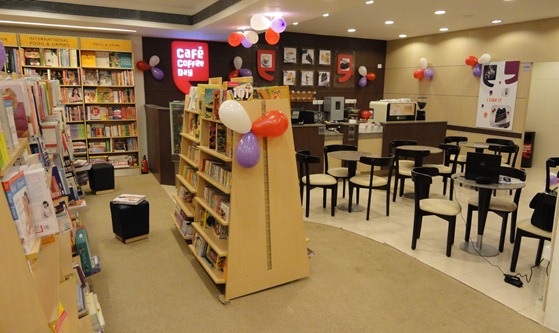 Crossword Book store with a Cafe Coffee day
Crossword Book store with a Cafe Coffee day
Having said that, are Indian consumers ready to go digital? Not yet.
Satya Rao, a Mumbai resident and an automotive consultant to a large US Conglomerate who has been an avid reader of books since his childhood across various categories says he would still walk into a Retail store to buy books, although he uses his iPad for various purposes other than reading online. Manish Malhotra, a Retail professional for over 15 years and a book-freak browses online these days to zero in on a relevant subset of books which he would later explore at a book store. Anjali, a HR professional working for an IT giant that makes life easier for Retailers worldwide by providing processes and solutions however feels the store visits are more about the exposure to a large range which is limited online. Raman Kalia, a marketing professional who has built an airline and an airport over the past 8 years feels being amongst books has a charm which cannot be replicated by online book retailers / websites since one is generally limited to what they know while browsing online while a physical book store opens up even more.
I personally remember (and so would many erstwhile Madrasis, a book store by the name “Seetharaman & Co.” – a one-stop shop which would house all forms of educational reading materials. The store was vertically graded and students from all across Madras would visit the store. It was quite rare that the Retailers (who was actually a distributor) would run out of stock. And if the store didn’t have what the customer wanted, it would be made available within a certain time frame. During the late 90s, a relatively larger, modern book store opened at Nungambakkam high road in Chennai. The store, which was located in the basement of a commercial complex was a haven for all kinds of books and was one of the first of its kind which allowed enthusiasts to read books endlessly, without compelling them to buy. Founder Hemu Ramiah later sold her stake in the book store to TATA’s Retail arm and the book store is none other than Landmark - A small neighbourhood book store that grew nationally to become one of the biggest and most respected Retailer of its kind in India over the years. M Madhu, the former Head of Merchandising of Landmark is reported to have recently moved on to head Amazon’s India operations – after all, who would know better than him how to entice readers by providing what they want.
So, what’s in store for Indian Book Retailers? Does the store size and titles that they carry will have an impact on the consumer’s requirements? Does providing amenities such as wide aisles, relaxed seating within air-conditioned precincts and a cafe here and there would be a strong hook to increase footfalls to the store? Do loyalty programs such as Crossword Reward programs or Landmark Fellowship to retain existing customers and increase their spends visit after visit? Well, while there are not too many clear answers for such questions, what’s sure is that Book Retailing is here to stay in India for quite some time to come. Reading is a habit, and is best to build such a habit from childhood. Many retailers have weekend activities targeting children – idea is to first bring them to the store; they would grow up reading themselves. On Digital – as mentioned before, India has its own constraints of e-commerce, starting from points of access to payment gateways. While things have improved a lot over the years, online security (or rather insecurity) is a looming factor that needs to be addressed by Retailers.
Online shopping or not, the charm of book stores would remain. For some its the romance of books and book-shelves, and for many its the enlightenment that they perceive they would get while browsing, buying and reading books. And for many, its just a customary visit every week to pick up magazines. Whichever way, Book stores are here to stay – just that the Retailers have to pull their act better, and yes NOW.
A Firefly finally takes off
Monday - 22 Jan. ‘24 is a very important day in my professional life. I complete eight months today in my role as Executive Vice President a...

-
12 December is celebrated annually as Retail Employees Day, an occasion to thank the frontend staff who have taken up Retail as their pref...
-
The world is split into two for the last week or so, ever since India’s self-made billionaire and tech mogul Mr. Narayana Murthy (NRN) said ...
-
It’s been over 5 months since I wrote anything on this blog, especially. Not that I didn’t have anything to observe, even better to share my...






